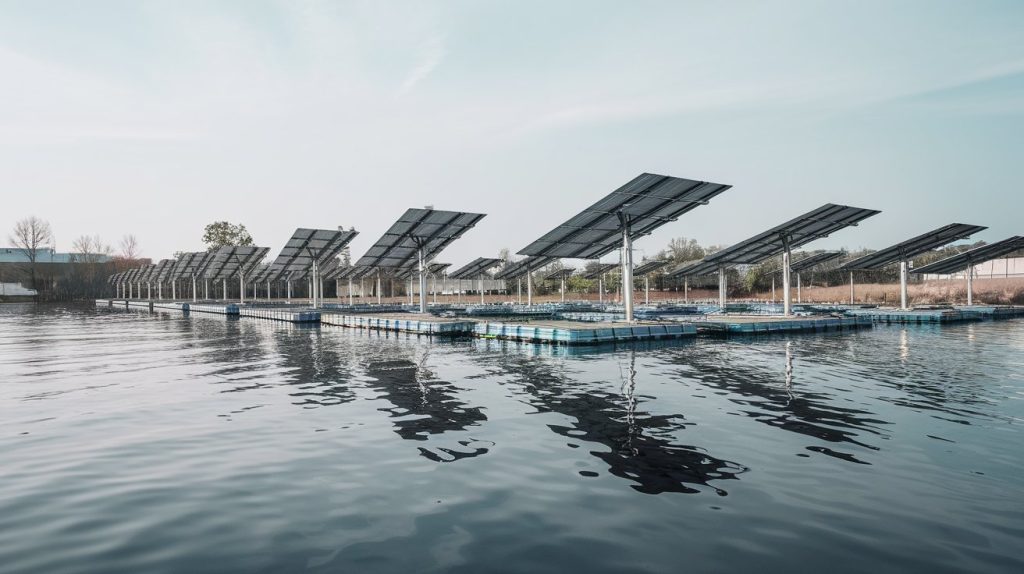What is Solar Energy Engineering? Unveiling the Science Behind Harnessing the Sun

In a world where the demand for sustainable energy solutions has never been greater, solar energy stands as a beacon of hope. Solar energy engineering is a multidisciplinary field dedicated to capturing the sun’s abundant energy and converting it into usable forms like electricity and heat. By merging principles from physics, material science, and environmental engineering, this field is driving innovations that are shaping a greener and more sustainable future.
Solar Energy Engineering Demystified

Blue solar photo voltaic panels system producing renewable clean energy on rural landscape and setting sun background.
At its core, solar energy engineering involves designing, developing, and optimising systems to efficiently harness the sun’s energy. This discipline combines technical expertise with creative solutions to address the global energy crisis. The primary aspects of solar energy engineering include:
- Designing Solar Energy Systems: Crafting systems that efficiently capture and convert sunlight into usable energy.
- Enhancing Photovoltaic Technology: Innovating photovoltaic (PV) cells and materials to improve energy conversion rates.
- Integrating Solar Solutions into Infrastructure: Creating systems that seamlessly integrate into residential, commercial, and industrial environments.
- Optimising Energy Storage and Distribution: Advancing energy storage technologies and distribution methods for reliable use across various applications.
Historical Context and Evolution of Solar Energy Engineering

Solar energy engineering has come a long way since the early days of photovoltaic (PV) cells. The first solar cell was developed in the 19th century, and while early versions were inefficient, today’s technologies are dramatically improving both performance and affordability. Over the decades, the cost of solar technology has decreased, making it more accessible, while innovations like thin-film and perovskite solar cells continue to shape the future.
The Core Components of Solar Energy Engineering

Solar energy engineering includes several key components that are crucial to harnessing solar power efficiently:
- Solar Power Generation: Photovoltaic (PV) cells convert sunlight directly into electricity. These cells are embedded in solar panels, which are commonly seen on rooftops, in solar farms, or in portable applications like solar-powered gadgets.
- Solar Thermal Technology: Unlike PV systems, solar thermal systems use sunlight to generate heat, which can be applied directly for tasks like water heating or used indirectly to generate electricity by driving turbines.
- Energy Storage and Distribution: Storing solar energy for later use and efficiently distributing it is key to making solar power reliable. Technologies like batteries play a crucial role in this process.
Harnessing Solar Energy: Key Technologies
The process of harnessing solar energy revolves around two main technologies:
- Photovoltaic (PV) Technology:
PV cells directly convert sunlight into electricity, forming the backbone of solar panels. Ongoing advancements in PV technology focus on enhancing energy efficiency and the durability of solar cells.
- Emerging Trends in PV Technology: Monocrystalline and polycrystalline solar cells have been popular for years, but the newest development—perovskite solar cells—holds promise for being cheaper to manufacture and more efficient. These cells could revolutionise the solar industry.
- Solar Thermal Technology:

These systems capture sunlight to heat fluids, which can be used for water heating, space heating, or large-scale electricity generation.
- Energy Storage and Distribution:

Effective energy storage is essential to making solar energy a dependable resource. By advancing storage technologies like batteries and integrating solar power into grids, solar engineers are ensuring that solar energy can be harnessed even when the sun isn’t shining.
Why Solar Energy Engineering is Crucial

Solar energy engineering addresses some of the most pressing global challenges:
- Energy Scarcity: Solar energy provides a sustainable alternative to depleting fossil fuels.
- Climate Change Mitigation: Solar power reduces greenhouse gas emissions, supporting environmental health.
- Energy Equity: It enables renewable energy solutions to reach underserved regions, promoting global development.
- Cost Savings: Solar systems offer long-term financial benefits by reducing electricity bills and maintenance costs.
Practical Applications of Solar Energy Engineering
Solar energy engineering impacts various aspects of everyday life and industry:
- Residential Solar Systems: Homeowners are increasingly turning to solar panels for electricity and water heating, providing energy independence and reducing costs.
- Commercial Solar Farms: Large-scale solar farms supply electricity to cities and industries, playing a pivotal role in reducing reliance on fossil fuels.
- Innovative Products: Portable solar solutions, such as streetlights, chargers, and even vehicles, are becoming more widespread, providing efficient and eco-friendly alternatives for diverse applications.
Emerging Solar Energy Innovations
- Floating Solar Farms:

These farms are built on bodies of water, maximising space usage in areas with limited land availability. Floating solar farms, like those in China and the U.S., can generate significant amounts of electricity while helping to preserve water resources by reducing evaporation.
- Solar Skins and Solar Roof Tiles:

Solar skins are thin, customisable layers that can be applied to solar panels, making them more aesthetically pleasing and easier to integrate into buildings. Similarly, solar roof tiles, which replace traditional roofing materials, offer a seamless way to incorporate solar energy into homes without visible panels.
Challenges and Solutions in Solar Energy Engineering
One of the key challenges in solar energy engineering is energy storage, as solar power is intermittent. Technologies like molten salt storage, which allows energy to be stored as heat, and smart grids, which manage the distribution of solar energy efficiently, are helping to solve this problem.

Grid Integration is another challenge, especially in regions with inconsistent sunlight or weather conditions. Advanced solutions, like hybrid solar-wind systems and better grid management tools, are becoming more common.
The Role of Artificial Intelligence in Solar Engineering
Artificial intelligence (AI) is revolutionising the solar energy sector. Through predictive maintenance and performance optimisation, AI can forecast energy production and identify issues before they arise. Machine learning algorithms are helping optimise energy storage by predicting solar panel output based on weather patterns, thus maximising energy usage and minimising waste.
Solar Energy’s Role in Global Sustainability

Solar energy is playing an integral role in achieving several United Nations Sustainable Development Goals (SDGs). By reducing carbon emissions and providing clean, affordable energy to all, solar engineering supports Goal 7: Affordable and Clean Energy and Goal 13: Climate Action. Moreover, solar energy can create jobs and foster economic development, especially in regions that lack reliable access to electricity.
Careers in Solar Energy Engineering
As the world embraces renewable energy, the demand for solar engineers is growing. Career opportunities include:
- Solar Design Engineers: Specializing in designing and installing solar systems.
- Research and Development: Innovating in photovoltaic technology and energy storage solutions.
- Renewable Energy Consultants: Advising organisations on integrating solar energy into various sectors.
- Field Technicians: Installing and maintaining solar panels and systems.
Aspiring professionals can pursue renewable energy engineering courses to acquire the skills necessary for this dynamic field.
The Role of Solar Engineers

Solar engineers are at the forefront of renewable energy innovation, undertaking several critical tasks:
- System Design: Crafting customised solutions for residential, commercial, and industrial projects.
- Optimisation: Fine-tuning solar energy systems to balance cost with energy output.
- Material Science Applications: Improving the efficiency and durability of photovoltaic cells and solar panels.
- Solar Power Generation: Developing advanced systems to supply clean, renewable energy.
These professionals are instrumental in ensuring solar systems are efficient, sustainable, and widely accessible.
The Future of Solar Energy Engineering
The future of solar energy is bright. Advancements in photovoltaic cell efficiency, energy storage technologies, and solar thermal systems are transforming how we harness the sun’s power. These innovations are making solar energy more accessible, reliable, and cost-effective.
Can solar energy power the future? The answer is yes. With continuous improvements in solar technology, including smart grids and AI-powered optimisation, solar energy engineering holds the key to a sustainable, clean, and energy-efficient future.
A Brighter Future with Solar Energy
Solar energy engineering is not just a scientific discipline; it’s a transformative force driving global sustainability efforts. By leveraging the power of the sun, this field addresses critical challenges like climate change, energy scarcity, and environmental degradation. Whether through innovative residential systems, large-scale solar farms, or groundbreaking research, solar energy engineering is lighting the path to a greener future. The opportunities to contribute are vast, and the impact is undeniable. Embracing solar energy is not merely an option—it’s a necessity for a sustainable planet.
https://www.technologyreview.com/2024/01/08/1085124/super-efficient-solar-cells-breakthrough-technologies/
https://energyevolutionexpo.com/top-innovations-solar-energy-technology/
https://8msolar.com/advancements-in-solar-panel-technology/
https://www.mckissock.com/blog/professional-engineering/how-to-become-a-solar-engineer/
https://www.reuters.com/business/energy/qcells-says-technology-breakthrough-could-reduce-space-needed-solar-panels-2024-12-18/
https://ratedpower.com/blog/solar-engineer/

